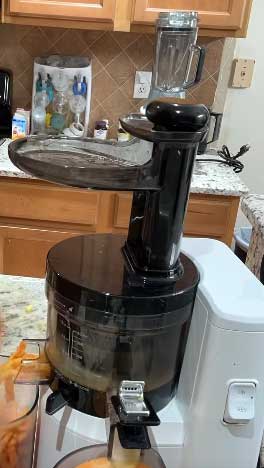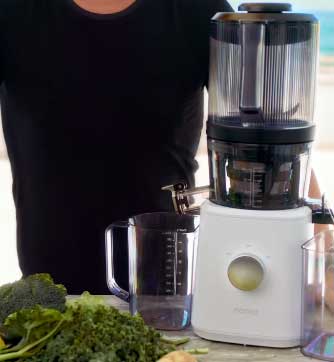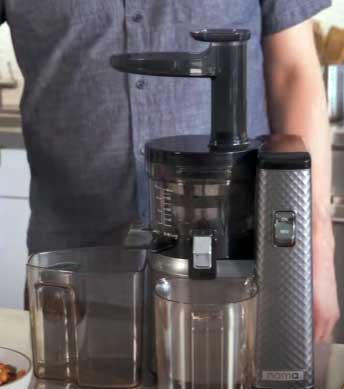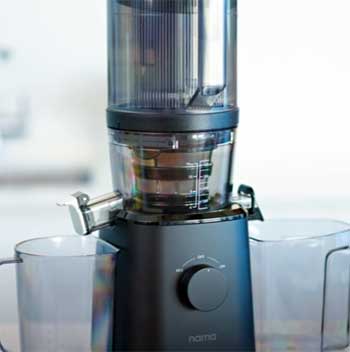I’ve been juicing for years, and when it comes to choosing the right machine, the Nama J1 and J2 stand out as top contenders.
My goal with this article is to share my firsthand experience with both, breaking down their features, performance, and quirks to help you decide which fits your lifestyle.
With a semantic SEO approach, I’ll cover the pros, cons, and key differences in a conversational, relatable way, ensuring you get a clear picture of what each juicer offers. Let’s get started with a quick comparison table, followed by my in-depth analysis.
A Brief Comparison Table
| Feature | Nama J1 | Nama J2 |
| Price | $399 (or ~$359 with discount) | $550 (or ~$495 with discount) |
| Feed Chute | Narrow (1.5 inches) | Wide (2.25 inches, hands-free) |
| Juicing Style | Manual, single-ingredient feed | Hands-free, batch juicing |
| Motor Power | 150 watts | 200 watts |
| Juice Yield | Up to 60% more than centrifugal | Up to 60% more than centrifugal |
| Functions | Juice, smoothies, nut milk, sorbet | Juice, smoothies, nut milk, sorbet (with attachment) |
| Warranty | 10 years | 15 years |
| Weight | 12.1 lbs | 12.5 lbs |
| Dimensions | 15.7″ H x 7.4″ W x 7.1″ D | 17.7″ H x 7.1″ W x 8.7″ D |
| Cleaning Time | ~3-4 minutes | ~3-4 minutes |
| Best For | Budget-conscious, small batches | Time-savers, large batches, versatility |
My Journey With Nama Juicers
I remember the first time I decided to get serious about juicing. I was tired of store-bought juices loaded with preservatives and wanted something fresh, nutrient-packed, and homemade.
That’s when I stumbled upon Nama, a brand that’s been making waves in the juicing world since their J1 hit the market in 2018. Fast forward to today, I’ve spent countless mornings with both the J1 and J2, squeezing everything from kale to apples to almonds. Both are fantastic, but they cater to slightly different needs.
Let me walk you through what makes each one tick, based on my own experience and hours spent experimenting in the kitchen.
Nama J1: The Budget-Friendly Workhorse
When I first got the Nama J1, I was drawn to its affordability. Priced at $399 (or around $359 with a discount code), it’s the more wallet-friendly option compared to the J2.
It’s a cold press juicer, meaning it slowly crushes and presses produce to extract juice, preserving nutrients and flavor better than those high-speed centrifugal models that sound like a jet engine.
Key Features of The Nama J1

The J1 has a 150-watt motor, which is less powerful than the J2 but still gets the job done for most produce.
Its narrow 1.5-inch feed chute requires you to chop fruits and veggies into smaller pieces—think bite-sized chunks for apples or halved carrots.
This prep work can feel tedious if you’re juicing large batches, but for single servings or small households, it’s manageable.
One thing I love about the J1 is its versatility.
It comes with strainers for juice, smoothies, and even nut milks, plus a sorbet attachment.
I’ve whipped up almond milk that’s creamier than anything I’ve bought at the store, and the sorbet feature is a game-changer for quick, healthy desserts.
The juice yield is impressive, too—Nama claims up to 60% more juice than centrifugal juicers, and from my tests with apples and celery, I’d say that’s spot-on. The pulp comes out dry, which means you’re getting every drop of goodness.
Cleaning the J1 takes about 3-4 minutes. The parts aren’t dishwasher-safe, which is a slight hassle, but they’re designed with smooth surfaces and minimal nooks, so a quick rinse and scrub does the trick.
At 12.1 pounds, it’s lightweight enough to move around my counter, and its compact size (15.7″ H x 7.4″ W x 7.1″ D) fits nicely in my small kitchen.
Pros of The Nama J1
- Affordable Price: At $399, it’s a great entry point for cold press juicing without breaking the bank.
- Versatile Functions: Juice, smoothies, nut milks, and sorbet—all in one machine.
- High Juice Yield: Extracts up to 60% more juice than centrifugal models, maximizing your produce.
- Compact and Lightweight: Perfect for small kitchens or frequent movers.
- Quiet Operation: Barely disturbs the peace, unlike those roaring centrifugal juicers.
- 10-Year Warranty: Solid coverage for peace of mind.
Cons of The Nama J1
- Narrow Feed Chute: Requires more prep time, chopping produce into small pieces.
- Less Powerful Motor: Struggles slightly with tougher produce like beets if not cut small.
- Manual Feeding: You have to feed ingredients one at a time, which can feel slow for big batches.
- No Dishwasher-Safe Parts: Hand-washing is a must, which might annoy some users.
I’ve found the J1 to be a reliable companion for my daily green juice routine. It’s perfect if you’re juicing for one or two people and don’t mind a bit of prep work to save some cash.
Nama J2: The Hands-Free Revolution
When I upgraded to the Nama J2, it felt like stepping into the future of juicing. Priced at $550 (or ~$495 with a discount), it’s a bigger investment, but the hands-free feature alone makes it worth considering.
Launched as an upgrade to the J1, the J2 takes convenience to a whole new level with its innovative batch juicing system.
Key Features of The Nama J2

The J2’s standout feature is its wide 2.25-inch feed chute and batch hopper, which lets you load an entire recipe’s worth of produce at once.
I can toss in whole apples, large chunks of cucumber, and handfuls of kale, then walk away while the machine does its thing.
This hands-free operation is a lifesaver when I’m multitasking in the kitchen or prepping juice for the week.
The 200-watt motor is more powerful than the J1’s, handling tough ingredients like ginger or beets with ease, even without extensive chopping.
Like the J1, the J2 produces up to 60% more juice than centrifugal juicers, and I’ve noticed the same dry pulp and vibrant juice quality. It comes with strainers for juice, smoothies, and nut milks, and Nama recently added a sorbet attachment (sold separately), which wasn’t available initially.
I’ve made silky smoothies and cashew milk that rival coffee shop quality, and the optional citrus attachment makes quick work of oranges without peeling.
The J2 is slightly larger (17.7″ H x 7.1″ W x 8.7″ D) and heavier (12.5 lbs) than the J1, but it’s still compact enough for most countertops. Cleaning takes about the same time as the J1—3-4 minutes of hand-washing.
The 15-year warranty is a nice upgrade over the J1’s 10 years, giving me extra confidence in its durability.
Pros of The Nama J2
- Hands-Free Juicing: Load the hopper and walk away—perfect for busy mornings or batch juicing.
- Wide Feed Chute: Less chopping means faster prep time.
- Powerful Motor: Tackles tough produce like beets or ginger with minimal effort.
- Versatile Attachments: Juice, smoothies, nut milks, and optional sorbet and citrus attachments.
- High Juice Yield: Matches the J1’s impressive extraction rate.
- 15-Year Warranty: Longer coverage for long-term reliability.
- Stylish Design: Available in matte black or white, it’s a sleek addition to any kitchen.
Cons of The Nama J2
- Higher Price: $550 is a significant jump from the J1’s $399.
- Slightly Larger Footprint: Takes up more counter space than the J1.
- No Dishwasher-Safe Parts: Like the J1, hand-washing is required.
- Sorbet Attachment Extra: Unlike the J1, the sorbet feature isn’t included and costs extra.
The J2 has been a game-changer for me, especially when I’m juicing for my family or prepping bottles for a juice cleanse. The hands-free feature saves me so much time, and the powerful motor makes the process feel effortless.
Head-to-Head Comparison of Nama J1 And J2 Juicer
Let’s break down the key differences I’ve noticed while using both juicers, focusing on the aspects that matter most in daily use.
- Price and Value

The J1’s $399 price tag makes it the clear choice for budget-conscious juicers.
I saved about $150 compared to the J2, which was a big deal when I was just starting out.
But the J2’s $550 price comes with features that justify the cost if you value convenience.
For me, the J2’s hands-free operation and reduced prep time were worth the extra investment, especially since I juice almost daily.
If you’re juicing occasionally or on a tight budget, the J1 offers nearly the same juice quality at a lower cost.
- Prep Time and Ease of Use
The J1’s narrow feed chute means I spend 5-10 minutes chopping produce before juicing, especially for larger items like apples or beets. This isn’t a dealbreaker for small batches, but it adds up if you’re making juice for a family.
The J2’s wide chute and batch hopper cut my prep time in half—I can toss in whole fruits or large chunks and let the machine handle the rest. This was a revelation when I was rushing to get breakfast ready or prepping multiple bottles for a juice fast.
- Juice Quality and Yield
Both juicers use cold press technology, so the juice quality is nearly identical. I’ve tested them with the same recipes—kale, apple, cucumber, and ginger—and the flavor, clarity, and nutrient retention are spot-on for both.
The dry pulp confirms Nama’s claim of up to 60% higher yield than centrifugal juicers. Whether I’m using the J1 or J2, I get vibrant, foam-free juice that lasts up to 72 hours in the fridge without separating.
- Versatility
Both machines are multi-talented, handling juice, smoothies, and nut milks with ease. The J1 has a slight edge out of the box because it includes the sorbet strainer, while the J2 requires you to purchase the sorbet attachment separately. However, the J2’s optional citrus attachment (not compatible with the J1) is a nice perk for citrus lovers.
I’ve used both for almond milk, and the results are equally creamy and delicious. If sorbet is a must-have, the J1 saves you the extra cost, but the J2’s broader accessory compatibility gives it a slight edge for versatility.
- Cleaning and Maintenance
Cleaning both juicers is straightforward but requires hand-washing, which takes about 3-4 minutes. The J2’s larger hopper has a few extra parts, but the difference in cleaning time is negligible. I’ve found that soaking the parts in warm water for a minute makes scrubbing easier for both.
If you hate hand-washing, neither juicer will win you over, but the process is simple enough that it hasn’t been a major issue for me.
- Design and Footprint
The J1’s compact size makes it ideal for my small apartment kitchen. It tucks neatly into a corner, and at 12.1 pounds, I can easily store it in a cabinet if needed. The J2 is taller and slightly wider, which might be a concern if counter space is tight.
That said, its sleek matte black or white finish looks so good that I don’t mind leaving it out. Both are quiet, which I appreciate since I often juice early in the morning without waking the household.
- Warranty and Durability
The J1’s 10-year warranty is solid, but the J2’s 15-year coverage gives me extra confidence in its long-term reliability. I’ve had no issues with either machine after months of use, and Nama’s customer service has been responsive when I’ve had questions about maintenance.
The J2 feels like a slightly sturdier build, likely due to its more powerful motor and larger components.
Which Juicer Fits Your Life?
To help you decide, let’s look at how the J1 and J2 perform in different scenarios based on my experience.

- Scenario 1: The Solo Juicer: If you’re like me when I started—juicing for yourself or maybe one other person—the J1 is a fantastic choice. Its compact size and lower price make it perfect for small households or beginners. I’d spend 5 minutes chopping veggies for a single 16-ounce juice, and the process felt meditative. The J1’s versatility means you can experiment with smoothies or nut milks without committing to a pricier machine.
- Scenario 2: The Family Juicer: When I started juicing for my partner and kids, the J2 became my go-to. Loading the hopper with enough produce for four 12-ounce juices saves me at least 10 minutes compared to the J1. The hands-free feature lets me prep breakfast or pack lunches while the juicer works, which is a huge win on busy mornings. If you’re juicing for a crowd or doing weekly batch prep, the J2’s convenience is unmatched.
- Scenario 3: The Health Enthusiast: As someone who’s done a few juice cleanses, I can say the J2 shines for large-scale juicing. I once made 22 eight-ounce bottles in one session with the J2, and it handled the workload like a champ. The J1 can do this too, but it requires more hands-on time feeding ingredients. Both deliver nutrient-packed juice, so either works for health-focused users, but the J2 saves significant time.
- Scenario 4: The Dessert Lover: I’m a sucker for healthy desserts, and the J1’s included sorbet strainer was a pleasant surprise. I’ve made banana “nice cream” and mango sorbet that my kids devour. The J2 can do this too, but you’ll need to buy the sorbet attachment separately, which adds to the cost. If sorbet is a priority, the J1 gives you that feature out of the box.
My Personal Take: Which One Should You Choose?
After months of using both, my choice depends on my needs at the time. The J1 was my first love—affordable, reliable, and perfect for my solo juicing days. But the J2 has become my daily driver because of its hands-free convenience and ability to handle larger batches.
If you’re on a budget or juicing for one, the J1 is a no-brainer. If you value time-saving features and plan to juice frequently or in bulk, the J2’s worth the splurge.
Frequently Asked Questions (FAQ)
The J1 is more affordable ($399) with a narrow feed chute, requiring manual feeding and more prep. The J2 ($550) offers hands-free batch juicing with a wider chute and a more powerful motor, ideal for larger batches and less chopping.
Both brands make excellent cold press juicers. Nama’s J2 stands out for its hands-free feature and sleek design, while Hurom offers similar juice quality with more model variety. Choose Nama for convenience, Hurom for customization options.
Yes, with the optional sorbet attachment, the J2 can process frozen fruit into sorbets or “nice cream.” Without it, stick to fresh produce for juicing or smoothies.
Both J1 and J2 require hand-washing, which can be tedious. The J1 needs more prep due to its narrow chute, while the J2’s higher price and larger size may not suit everyone. The J2’s sorbet attachment is an extra cost.
Conclusion: Your Juicing Journey Starts Here
You’ve got a big decision ahead, and I hope my experience with the Nama J1 and J2 has given you clarity. Whether you’re leaning toward the budget-friendly J1 or the time-saving J2, both deliver exceptional juice quality and versatility.
Think about your lifestyle—how often you’ll juice, how much prep time you can handle, and your budget.
For me, the J2’s hands-free magic won out, but the J1 still holds a special place for its affordability and reliability. Whichever you choose, you’re investing in fresher, healthier juices. So, what’s it going to be? Let me know how your juicing adventure goes!
